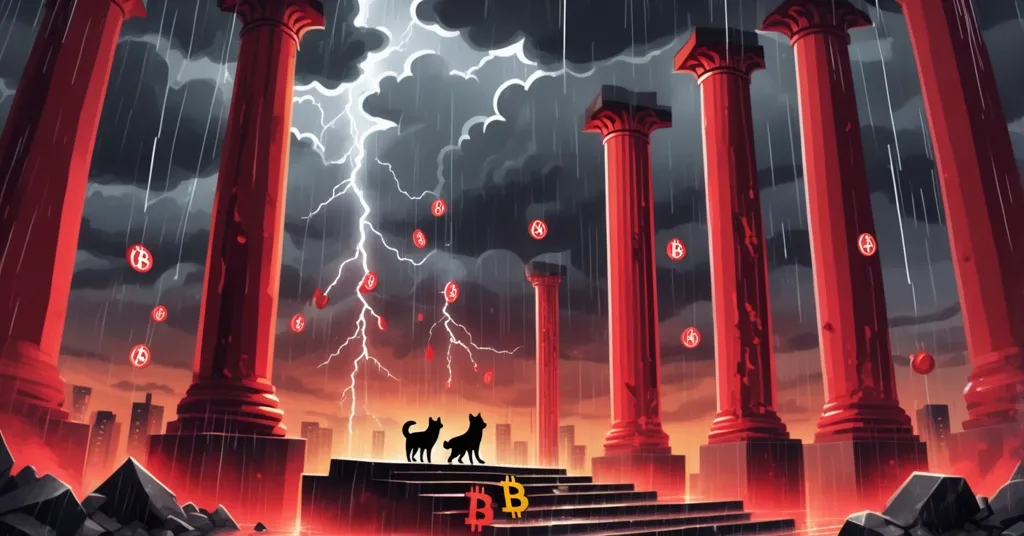Crypto Market Crash: XRP, SHIB, Bitcoin Prices Plummet—What’s Next for Investors?

Crypto Market Crash: XRP, Shiba Inu, Bitcoin Prices Drop—What’s Next?
The crypto market is in a brutal tailspin, with heavyweights like XRP, Shiba Inu (SHIB), and Bitcoin (BTC) taking significant hits. XRP’s fleeting recovery has crumbled into a bearish slump, SHIB is haunted once again by its infamous “evil zero,” and Bitcoin has stumbled from a tantalizing $110,000 high. Let’s break down the carnage, analyze the forces at play, and cut through the noise to understand what might be coming down the pike.
- XRP’s Downfall: A 1.7% daily drop, failing to hold $2.50 resistance, with further declines on the horizon.
- SHIB’s Evil Zero: Crashes below $0.0000099 to $0.0000090, despite massive token outflows signaling potential long-term hope.
- Bitcoin’s Retreat: Slips 1.8% in a day from $110K to $108K, pressured by selling waves and fading institutional interest.
Why Is the Market Bleeding?
Beyond the individual struggles of XRP, SHIB, and Bitcoin, the broader crypto market is grappling with systemic headwinds. Macroeconomic pressures like rising interest rates from central banks worldwide are siphoning liquidity out of risk assets, including cryptocurrencies. Higher rates make safer investments like bonds more attractive, leaving speculative markets like ours in the dust. Regulatory uncertainty also looms large—think China’s unrelenting crypto bans or the EU’s tightening grip through frameworks like MiCA, which could impose stricter rules on exchanges and stablecoins. Then there’s the post-rally profit-taking; after Bitcoin’s surge to $110K, likely fueled by retail FOMO and sporadic big-money buys, many investors are cashing out, triggering a domino effect across altcoins. This isn’t just a blip—it’s a reminder that crypto doesn’t operate in a vacuum. External forces can hit as hard as internal sentiment, and right now, both are swinging bearish.
XRP: A Rally Gone Wrong
XRP, the token powering the Ripple network for cross-border payments, has flipped from a brief bullish tease to a stark bearish plunge. A 1.7% drop in just 24 hours saw it fail to cling to the critical $2.50 resistance—a price point traders watch as both a psychological barrier and a technical ceiling. Since late August, XRP’s price has been sliding in a descending channel. This pattern, marked by consistently lower peaks and dips, screams seller dominance. Currently trading below its 200-day moving average—a long-term trend line that signals trouble when breached downward—XRP looks vulnerable. Its Relative Strength Index (RSI), a momentum gauge, sits below 40, far from the overbought territory above 70 and even below the neutral 50 mark, pointing to weak buying interest. If selling persists, support levels at $2.20 and $2.00 could be tested soon, with a potential nosedive to $1.00 if sentiment doesn’t shift. Resistance hovers at $2.70-$2.80, but breaking that looks like a distant fantasy without a catalyst.
What could spark a turnaround? A favorable outcome in Ripple’s ongoing legal battle with the SEC over whether XRP is an unregistered security might inject life into the token. New partnerships or adoption in the remittance space—where XRP aims to outpace slow, costly traditional systems—could also help. But let’s not kid ourselves: XRP’s RSI below 40 echoes patterns from its brutal 2018 crash, where recovery dragged on for months without a game-changer. For holders, this feels like a relentless loop of dashed hopes. Are we too quick to hit the panic button, or has XRP lost its edge in an increasingly crowded altcoin arena? For more on XRP’s bearish turn, check out this detailed market prediction.
Shiba Inu: The Curse of the Evil Zero
Shiba Inu (SHIB), the meme coin that skyrocketed on hype in 2021, is back to tormenting its community with the so-called “evil zero”—that extra digit in its price symbolizing its struggle to gain real traction. After teasing a recovery, SHIB has collapsed below the psychologically significant $0.0000099 level, now limping along at $0.0000090 with a 2% daily loss. These psychological barriers aren’t always tied to hard data but carry emotional weight—breaking below often sparks panic selling among retail investors. The technical picture is ugly: SHIB trades under its 50-, 100-, and 200-day moving averages, all critical trend markers, while its RSI also wallows below 40. Declining trading volume suggests buyers are nowhere in sight, and further drops to $0.0000085 or even $0.0000075 could be next—a bitter pill for anyone still holding from the meme coin mania days.
Yet, there’s a flicker of hope beneath the gloom. Over 81 billion SHIB tokens—81,004,189,771 to be precise—have recently flowed out of exchanges into private wallets. This move typically signals that investors are parking their holdings for the long haul, reducing immediate selling pressure on the market. If demand picks back up, this scarcity could nudge prices higher. Community efforts like the Shibarium layer-2 solution, meant to lower transaction costs and boost utility, also deserve a nod. Still, let’s not get carried away—current bearish momentum overshadows these positives. It’s like the boogeyman of meme coins: just when SHIB holders think they’ve escaped, that pesky zero creeps back to haunt their portfolios.
Bitcoin: The King Takes a Hit
Bitcoin, the undisputed leader of the crypto realm, briefly touched $110,000, sending maximalists into a frenzy, only to crash back to $108,000 with a 1.8% daily loss. What dragged it down? A perfect storm of increased selling volume on exchanges, a noticeable dip in institutional inflows, and a surge in short positions in derivatives markets where traders bet on further declines. Think of institutional money as a massive ship entering port—its arrival lifts all boats with bullish momentum. When it sails away, the waters turn choppy, and that’s where Bitcoin finds itself now. Immediate support sits at $106,000, tied to its 200-day moving average, but if that breaks, a slide to $102,000 isn’t far-fetched. Resistance looms between $112,000 and $114,000, where sellers have historically capped gains. With an RSI between 40 and 45, neither oversold nor overbought, Bitcoin might be gearing up for consolidation—sideways action that leaves traders itching for direction.
Despite the dip, Bitcoin’s fundamentals as a store of value—often dubbed “digital gold”—and a hedge against inflation remain stronger than most. Holding roughly 50% of the total crypto market dominance, its movements often dictate the fate of altcoins. But let’s play devil’s advocate: with central banks hiking rates and fiat looking like a safer bet to some, is the “digital gold” narrative holding up in today’s climate? Upcoming events like potential ETF approvals or the next halving cycle, which cuts mining rewards and historically sparks rallies, could reignite bullish fire. For now, though, this looks like classic profit-taking after a rally—or are we peering into a deeper correction? Only a fresh wave of big-money buys might answer that.
Crypto Trading 101: Key Terms Explained
For those new to the game, here’s a quick breakdown of the technical terms shaping today’s analysis. A moving average is a trend line averaging past prices over a set period (like 50 or 200 days)—trading below it often signals bearish momentum, while above hints at bullish strength. The Relative Strength Index (RSI) measures price momentum on a 0-100 scale: above 70 suggests an asset is overbought (potentially overpriced), below 30 indicates oversold (possibly undervalued), and 40-50 often marks neutral or weakening territory. Support is a price level where buying interest typically emerges to halt declines, while resistance is where selling pressure caps gains. A descending channel shows a price falling with lower highs and lows, reflecting seller control. These tools help traders predict moves, but they’re not crystal balls—markets can defy logic in a heartbeat.
Broader Implications: Cycles, Dominance, and Utility
Zooming out, the crypto market feels like it’s nursing a hangover after a wild party. Euphoric pumps, likely driven by retail fear of missing out and bursts of institutional buying, have given way to a harsh corrective phase. This isn’t breaking news—crypto’s history is littered with such cycles, where sky-high optimism crashes into brutal reality. What’s striking now is the uniform bearish outlook across XRP, SHIB, and Bitcoin: low RSIs, broken trend lines, and shrinking volumes spell caution, if not outright dread. Yet, for every seller bailing out, a bargain hunter might be waiting in the wings. Bitcoin’s dominance as the market’s anchor often means its stabilization could lift all boats, but when it wobbles, altcoins tend to bleed harder.
As Bitcoin maximalists, we see BTC as the bedrock of financial freedom and privacy—a decentralized bulwark against centralized control. But we can’t ignore the niche roles altcoins carve out. XRP’s focus on slashing costs and delays in cross-border payments tackles a problem Bitcoin isn’t built for. SHIB, for all its meme-driven chaos, fuels community experiments and engagement in ways BTC’s stoic “digital gold” ethos doesn’t. Still, let’s not drink the Kool-Aid—wild claims of “Bitcoin to $200K by year-end” or “SHIB to a penny” are pure shilling garbage. The data laughs at such nonsense, and we’re here to push adoption through real utility, not empty hype. Scammers and pump-and-dump peddlers promising moonshots on social media? Call them out for the frauds they are. Stick to the numbers and the tech; that’s where the future lies.
What Could Turn This Around?
Looking ahead, a few catalysts could shift this bearish tide. For Bitcoin, renewed institutional interest—perhaps through spot ETF approvals in major markets—could pour fresh capital back in. The upcoming halving, slashing miner rewards and historically tightening supply, looms as a potential rally trigger. XRP’s fate might hinge on a legal win against the SEC or expanded adoption by financial institutions for remittances. SHIB could see a boost if Shibarium gains traction or if token burns—removing coins from circulation to create scarcity—ramp up significantly. Broader market tailwinds like DeFi (decentralized finance) growth, where blockchain protocols replace traditional banking services, or clearer global regulations could rebuild confidence. But let’s be real: these are possibilities, not promises. Short-term pain might linger before long-term gains emerge. History tells us volatility is the toll we pay for innovation—so who’s still standing when the storm passes?
Key Takeaways and Questions to Ponder
- Why Is XRP Price Dropping in 2023?
A 1.7% daily loss, inability to break $2.50 resistance, and technicals like an RSI below 40 plus a descending channel since August show sellers firmly in charge. - Is Shiba Inu’s Token Outflow a Bullish Signal Amid Decline?
Yes, 81 billion SHIB moving off exchanges cuts selling pressure, potentially paving the way for gains if demand returns, even as the price sags at $0.0000090. - What Pushed Bitcoin Down from $110,000?
Heavy selling on exchanges, dwindling institutional inflows, and rising short bets in derivatives markets have pulled BTC to $108,000 with bearish undertones. - Which Price Levels Matter for XRP, SHIB, and Bitcoin?
XRP support lies at $2.20, $2.00, or down to $1.00; SHIB at $0.0000085-$0.0000075; Bitcoin at $106,000-$102,000, with resistances at $2.70-$2.80, $0.0000100, and $112,000-$114,000 respectively. - Do Technical Indicators Hint at a Crypto Market Recovery?
Not yet—RSI below 40 for XRP and SHIB, Bitcoin’s neutral 40-45, and prices below key moving averages signal weak buying momentum and persistent bearish pressure. - How Do Macro Factors Impact Crypto Prices?
Rising interest rates, regulatory crackdowns, and post-rally profit-taking are draining liquidity and confidence from risk assets like cryptocurrencies, fueling this downturn.
As staunch advocates for decentralization and disruption, we view these brutal dips as part of the raw, messy path to a financial revolution. Bitcoin stands as the pillar of freedom and privacy, even when the charts turn grim. Altcoins like XRP and SHIB, despite their stumbles, test boundaries in payments and community dynamics that Bitcoin doesn’t aim to touch. These downturns bite hard, no question, but they also act as a filter—separating fleeting hype from lasting substance. If we’re serious about effective accelerationism, these shakeouts are vital stress tests, exposing weak projects and forcing the space to prioritize utility over empty promises. Markets may bleed today, but the tech—blockchain, smart contracts, decentralized systems—grinds on. Stay vigilant, stack sats when the price feels right, and ignore the noise. The blueprint for the future of money is still taking shape, and we’re all in on drafting it.



